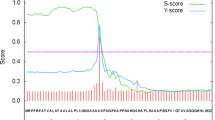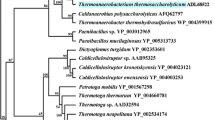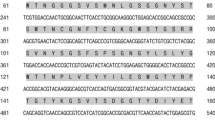Abstract
Streptomyces sp. CSWu2 was newly isolated and identified from Korean soil. In culture medium, the strain produced a highly active endoxylanase (Xynwu2), which was purified to homogeneity by a single-step chromatography on Poros-HQ. The xylanase was ~38 kDa and its activity was maximal at 65 °C and pH 11.0. It was stable up to 60 °C and from pH 8.0 to 12.0, and its activity was slightly enhanced by nonionic detergents, but inhibited by EDTA, EGTA, and divalent metal ions. Intriguingly, Xynwu2 was highly sensitive to ammonium sulfate, but its completely suppressed activity was recovered by desalting out. Xynwu2 produced xylose and xylobiose as principal end products from xylan, suggesting an endoxylanase nature. Importantly, scanning electron microscopy showed Xynwu2 efficiently degraded corncobs, an agro-industrial waste material. We believe that Xynwu2 is a potential candidate for converting lignocellulosic waste material into simple sugars which could be used to produce bioethanol and other value-added products.





Similar content being viewed by others
References
Beg QK, Kapoor M, Mahajan L, Hoondal GS (2001) Microbial xylanases and their industrial applications: a review. Appl Microbiol Biotechnol 56(3):326–338
Collins T, Gerday C, Feller G (2005) Xylanases, xylanase families and extremophilic xylanases. FEMS Microbiol Rev 29(1):3–23
Shin J-H, Choi J-H, Lee O-S, Kim Y-M, Lee D-S, Kwak Y-Y, Kim W-C, Rhee I-K (2009) Thermostable xylanase from Streptomyces thermocyaneoviolaceus for optimal production of xylooligosaccharides. Biotechnol Bioprocess Eng 14(4):391–399
Ai Z, Jiang Z, Li L, Deng W, Kusakabe I, Li H (2005) Immobilization of Streptomyces olivaceoviridis E-86 xylanase on Eudragit S-100 for xylo-oligosaccharide production. Process Biochem 40(8):2707–2714
Vázquez MJ, Alonso JL, Domínguez H, Parajó JC (2000) Xylooligosaccharides: manufacture and applications. Trends Food Sci Technol 11(11):387–393
Verma D, Satyanarayana T (2012) Cloning, expression and applicability of thermo-alkali-stable xylanase of Geobacillus thermoleovorans in generating xylooligosaccharides from agro-residues. Bioresour Technol 107:333–338
Qiu Z, Shi P, Luo H, Bai Y, Yuan T, Yang P, Liu S, Yao B (2010) A xylanase with broad pH and temperature adaptability from Streptomyces megasporus DSM 41476, and its potential application in brewing industry. Enzym Microb Technol 46(6):506–512
Zhou J, Shi P, Zhang R, Huang H, Meng K, Yang P, Yao B (2011) Symbiotic Streptomyces sp. TN119 GH 11 xylanase: a new pH-stable, protease- and SDS-resistant xylanase. J Ind Microbiol Biotechnol 38(4):523–530
Deesukon W, Nishimura Y, Harada N, Sakamoto T, Sukhumsirichart W (2011) Purification, characterization and gene cloning of two forms of a thermostable endo-xylanase from Streptomyces sp. SWU10. Process Biochem 46(12):2255–2262
Nanmori T, Watanabe T, Shinke R, Kohno A, Kawamura Y (1990) Purification and properties of thermostable xylanase and beta-xylosidase produced by a newly isolated Bacillus stearothermophilus strain. J Bacteriol 172(12):6669–6672
Simkhada J, Cho S, Choi H, Kim S, Lee H, Sohng J, Yoo J (2010) A new thermolabile alkaline phospholipase D from Streptomyces sp. CS628. Biotechnol Bioprocess Eng 15(4):595–602
Bradford MM (1976) A rapid and sensitive method for the quantitation of microgram quantities of protein utilizing the principle of protein–dye binding. Anal Biochem 72:248–254
Miller GL (1959) Use of dinitrosalicylic acid reagent for determination of reducing sugar. Anal Chem 31(3):426–428
Laemmli UK (1970) Cleavage of structural proteins during the assembly of the head of bacteriophage T4. Nature 227(5259):680–685
Sriyapai T, Somyoonsap P, Matsui K, Kawai F, Chansiri K (2011) Cloning of a thermostable xylanase from Actinomadura sp. S14 and its expression in Escherichia coli and Pichia pastoris. J Biosci Bioeng 111(5):528–536
Li X, She Y, Sun B, Song H, Zhu Y, Lv Y, Song H (2010) Purification and characterization of a cellulase-free, thermostable xylanase from Streptomyces rameus L2001 and its biobleaching effect on wheat straw pulp. Biochem Eng J 52(1):71–78
Yan Q, Hao S, Jiang Z, Zhai Q, Chen W (2009) Properties of a xylanase from Streptomyces matensis being suitable for xylooligosaccharides production. J Mol Catal B Enzym 58(1–4):72–77
Kaneko S, Kuno A, Muramatsu M, Iwamatsu S, Kusakabe I, Hayashi K (2000) Purification and characterization of a family G/11 β-xylanase from Streptomyces olivaceoviridis E-86. Biosci Biotechnol Biochem 64(2):447–451
Ninawe S, Kapoor M, Kuhad RC (2008) Purification and characterization of extracellular xylanase from Streptomyces cyaneus SN32. Bioresour Technol 99(5):1252–1258
Wang S-L, Yen Y-H, Shih I-L, Chang AC, Chang W-T, Wu W-C, Chai Y-D (2003) Production of xylanases from rice bran by Streptomyces actuosus A-151. Enzym Microb Technol 33(7):917–925
Kim DY, Han MK, Oh H-W, Park D-S, Kim S-J, Lee S-G, Shin D-H, Son K-H, Bae KS, Park H-Y (2010) Catalytic properties of a GH10 endo-β-1,4-xylanase from Streptomyces thermocarboxydus HY-15 isolated from the gut of Eisenia fetida. J Mol Catal B Enzym 62(1):32–39
Giridhar PV, Chandra TS (2010) Production of novel halo-alkali-thermo-stable xylanase by a newly isolated moderately halophilic and alkali-tolerant Gracilibacillus sp. TSCPVG. Process Biochem 45(10):1730–1737
Techapun C, Poosaran N, Watanabe M, Sasaki K (2003) Thermostable and alkaline-tolerant microbial cellulase-free xylanases produced from agricultural wastes and the properties required for use in pulp bleaching bioprocesses: a review. Process Biochem 38(9):1327–1340
Acknowledgments
This work was supported by the National Research Foundation of Korea (NRF) grant funded by the Korean government (MEST) (2010-0029178) and a grant from the Next-Generation BioGreen 21 Program (No. PJ008140), Rural Development Administration, Republic of Korea.
Author information
Authors and Affiliations
Corresponding authors
Additional information
Jaya Ram Simkhada and Hah Young Yoo contributed equally to this work.
Rights and permissions
About this article
Cite this article
Simkhada, J.R., Yoo, H.Y., Park, D.H. et al. An ammonium sulfate sensitive endoxylanase produced by Streptomyces . Bioprocess Biosyst Eng 36, 819–825 (2013). https://doi.org/10.1007/s00449-013-0908-4
Received:
Accepted:
Published:
Issue Date:
DOI: https://doi.org/10.1007/s00449-013-0908-4




